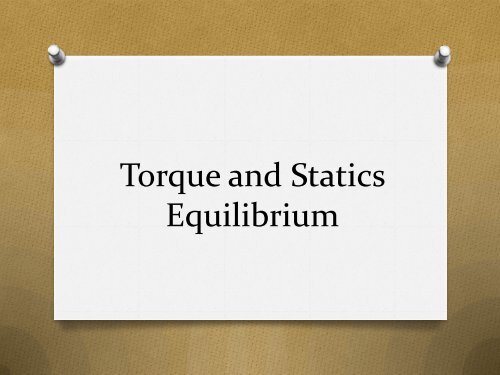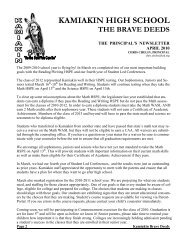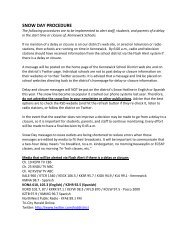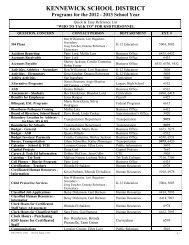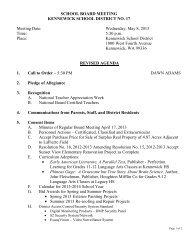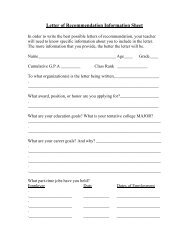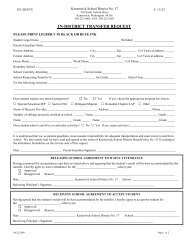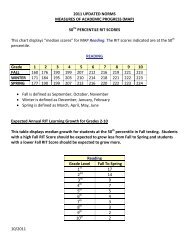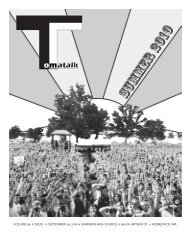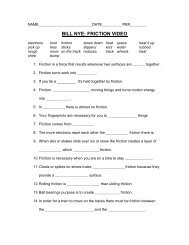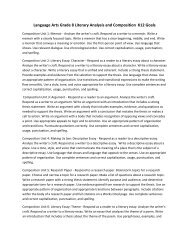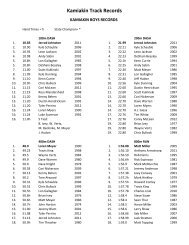Torque and Statics Equilibrium
Torque and Statics Equilibrium
Torque and Statics Equilibrium
Create successful ePaper yourself
Turn your PDF publications into a flip-book with our unique Google optimized e-Paper software.
<strong>Torque</strong> <strong>and</strong> <strong>Statics</strong><br />
<strong>Equilibrium</strong>
Objectives<br />
O Students should underst<strong>and</strong> the concept of torque, so<br />
they can:<br />
O Calculate the magnitude <strong>and</strong> direction of the torque<br />
associated with a given force.<br />
O Calculate the torque on a rigid object due to gravity.<br />
O Students should be able to analyze problems in statics,<br />
so they can:<br />
O State the conditions for translational <strong>and</strong> rotational<br />
equilibrium of a rigid object.<br />
O Apply these conditions in analyzing the equilibrium of a<br />
rigid object under the combined influence of a number of<br />
coplanar forces applied at different locations.
8-4: <strong>Torque</strong><br />
O To make an object start rotating, a force is needed; the<br />
position <strong>and</strong> direction of the force matter as well.<br />
O The perpendicular distance from the axis of rotation to<br />
the line along which the force acts is called the lever<br />
arm.<br />
O The torque is defined as:<br />
τ = rF sin θ
O The most efficient direction of force is perpendicular to<br />
a radius from the axis of rotation, <strong>and</strong> the least efficient<br />
direction is parallel to a radius form the axis of rotation.<br />
O <strong>Torque</strong> is additive when force is applied in the same<br />
angular direction, <strong>and</strong> it is subtracted when applied in<br />
the opposite angular direction.<br />
O Counterclockwise torque is, by convention, a positive<br />
quantity, whereas clockwise torque is considered a<br />
negative quantity
Example 8-8: Biceps torque<br />
O The biceps muscle exerts a<br />
vertical force on the lower<br />
arm as shown in figure (a)<br />
<strong>and</strong> (b). For each case,<br />
calculate the torque about the<br />
axis of rotation through the<br />
elbow joint, assuming the<br />
muscle is attached 5 cm from<br />
the elbow as shown.
Exercise B<br />
O Two forces (F B = 20 N <strong>and</strong> F A = 30 N) are applied to a<br />
meter stick which can rotate about its left end. Force F B<br />
is applied perpendicularly at the midpoint. Which force<br />
exerts the greater torque?
Example 8-9: <strong>Torque</strong> on a compound wheel<br />
O Two thin disk-shaped wheels, of radii r A = 30 cm<br />
<strong>and</strong> r B = 50 cm, are attached to each other on an<br />
axle that passes through the center of each, as<br />
shown. Calculate the net torque on this compound<br />
wheel due to the two forces shown, each of<br />
magnitude 50 N.
9-1: The Conditions for <strong>Equilibrium</strong><br />
O An object with forces acting on it, but that is not<br />
moving, is said to be in equilibrium.<br />
O The first condition for equilibrium is that the forces<br />
along each coordinate axis add to zero.<br />
O The second condition of equilibrium is that there be<br />
no torque around any axis; the choice of axis is<br />
arbitrary.
Example 9-1: Straightening teeth<br />
O The wire b<strong>and</strong> shown has a tension F T of 2 N along it. It<br />
therefore exerts forces of 2.0 N on the highlighted tooth<br />
(to which it is attached) in the two directions shown.<br />
Calculate the resultant force on the tooth due to the<br />
wire, F R .
Example 9-2: Ch<strong>and</strong>elier cord tension<br />
O Calculate the tensions F A <strong>and</strong> F B in the two cords<br />
that are connected to the vertical cord supporting<br />
the 200-kg ch<strong>and</strong>elier.
Exercise A<br />
O In Example 9-2, F A has to be greater than the<br />
ch<strong>and</strong>elier’s weight, mg. Why?
Example 9-3: A lever<br />
O The bar shown is being used as a lever to pry up a large<br />
rock. The small rock acts as a fulcrum (pivot point). The<br />
force F P required at the long end of the bar can be quite<br />
a bit smaller than the rock’s weight mg, since it is the<br />
torques that balance in the rotation about the fulcrum.<br />
If, however, the leverage isn’t sufficient, <strong>and</strong> the large<br />
rock isn’t budged, what are two ways to increase the<br />
leverage?
Exercise B<br />
O For simplicity, we wrote the equation in Example 9-3 as<br />
if the lever were perpendicular to the forces. Would the<br />
equation be valid even for a lever at an angle as shown<br />
in the figure.
9-2: Solving <strong>Statics</strong> Problems<br />
1. Choose one object at a time, <strong>and</strong> make a free-body<br />
diagram showing all the forces on it <strong>and</strong> where they<br />
act.<br />
2. Choose a coordinate system <strong>and</strong> resolve forces into<br />
components.<br />
3. Write equilibrium equations for the forces.<br />
4. Choose any axis perpendicular to the plane of the<br />
forces <strong>and</strong> write the torque equilibrium equation. A<br />
clever choice here can simplify the problem<br />
enormously.<br />
5. Solve.
Example 9-4: Balancing a seesaw<br />
O A board of mass M = 2.0 kg serves as a seesaw for two<br />
children. Child A has a mass of 30 kg <strong>and</strong> sits 2.5 m<br />
from the pivot point, P (his center of gravity is 2.5 m<br />
from the pivot). At what distance x from the pivot must<br />
child B, of mass 25 kg, place herself to balance the<br />
seesaw? Assume the board is uniform <strong>and</strong> centered<br />
over the pivot.
Exercise C<br />
O We did not need to use the force equation to solve<br />
Example 9-4 because of our choice of the axis. Use the<br />
force equation to find the force exerted by the pivot.
Example 9-5: Forces on a beam <strong>and</strong> supports<br />
O A uniform 1500-kg beam, 20.0 m long, supports a<br />
15,000-kg printing press 5.0 m from the right support<br />
column. Calculate the force on each of the vertical<br />
support columns.
Example 9-6: Hinged beam <strong>and</strong> cable<br />
O A uniform beam, 2.20 m long with mass m = 25.0 kg, is<br />
mounted by a hinge on a wall as shown. The beam is<br />
held in a horizontal position by a cable that makes an<br />
angle θ = 30° as shown. The beam supports a sign of<br />
mass M = 28.0 kg suspended from its end. Determine<br />
the components of the force F H that the hinge exerts on<br />
the beam, <strong>and</strong> the tension F T in the supporting cable.


